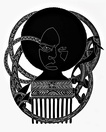Glen Mackie (Kei Kalak) in collaboration with Theo Tremblay
Gimuy Walaburra Yidinji/Yirrangangi Country, Gimuy/Cairns, Queensland
2023
Displayed 2023 at Art Gallery of New South Wales

Glen Mackie (Kei Kalak)
Kulkalgal people.
Born 1975, Kala Lagaw Ya Country, Iama/Yam Island, Zenadth Kes/Torres Strait Islands.
Lives and works Gimuy Walaburra Yidinji/Yirrangangi Country, Gimuy/Cairns, Queensland.
Glen Mackie (Kei Kalak) is from Iama/Yam Island, and his totems are the hammerhead shark and the crocodile. His bold minarr, or infill-design style, incorporates family totemic designs as well as his own invented repeating patterns. He retells the myths and stories he inherited from older family members, and credits his artist grandfather for teaching him to carve. As Iama’s only practising artist, he feels a responsibility to keep alive the sacred stories of the four brothers who travelled from the north before memory and settled the Zenadth Kes. Mackie fiercely wants to preserve his culture by retelling the stories of his community for the benefit of young people of the Islands and the general public.
Artist text
by Erin Vink
Glen Mackie, also known as Kei Kalak (Big Boy), is part of the transition generation of Kala Lagaw Ya artists, originally from the central islands of the Zenadth Kes/Torres Strait Islands between the border of Cape York and Papua New Guinea (PNG), who predominantly live and work in Gimuy/Cairns to revitalise language and culture through new modes of storytelling. The Zenadth Kes have a distinct cultural inheritance that is more connected to the Great Ocean people of PNG and the Solomon Islands, rather than to the Aboriginal people of mainland Australia. Here, historically, the practice of wood carving has been managed for many millennia to document seafaring and family histories, along with the ancient knowledges of culture protected by each island’s Elders. Since the mid-1980s, artists from Zenadth Kes have been transferring these skills to the process of printmaking, and Mackie has been at the forefront of this movement since the 1990s.
Mackie’s work for The National 4 is a multi-media installation which explores this practice. It includes an acrylic sticker of his vinyl-cut print Kei Athe Mosby (Yankee Ned Mosby) (2010) installed on glass, along with four new prints and a painted mural, all of which depict the tales of his great, great, great-grandfather Edward ‘Yankee Ned’ Mosby, an American Jewish sailor, who likely arrived in the Zenadth Kes through the whaling and pearling industries of the 1860s, and his great, great, great-grandmother, Kudin, who hailed from Masig/Yorke Island.
Oral histories have been handed down through the generations which recount Yankee Ned’s relationship with Kudin, how he was accepted by her island community of Masig after thwarting and defending their island during an attempted raid by Mer/Murray Island warriors, and his role in bringing the first form of western civilisation and rule to Masig following Yankee Ned’s employment of a non-Indigenous schoolmaster to teach the island’s children. Yet Kudin’s role in the Mosby family history is not overlooked; she appears here in the installation across both prints, with Mackie honouring the role she played as a mother, wife, and grandmother. Alive with movement, these tales unfold across the installation and flow between works with the bold minarr (patterning) which incorporates the artist’s family totemic designs.
Also included in this installation are Mackie’s story boats, which hover over a void between levels. These luggers again reference the Zenadth Kes' pearling history, and explore the extractivism of Country. By using the form of a lugger, a vehicle that has literally transported the riches of Country across the seas, Mackie reflects on the international peoples who entered Country, particularly those who did so in an appropriate way to respect Country and culture. These luggers are also a nod to the commercial success of Mackie’s great, great, great-grandfather, who, by the end of his life, owned a fleet of five luggers and two cutters, which are illustrated and run the top length of his print Kei Athe Mosby (Yankee Ned Mosby). Mackie’s minarr covers the luggers, reminding the viewer that these designs have been firmly attached to place since time immemorial. They also signal the artist’s responsibilities to keep Country and culture strong.
Artist's acknowledgements
The artist thanks Theo Tremblay at Editions Tremblay NFP and Paloma Ramos at Canopy Art.
Glen Mackie is represented by Canopy Art, Cairns.






